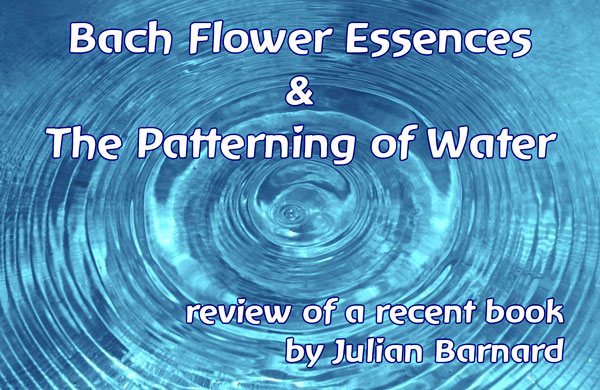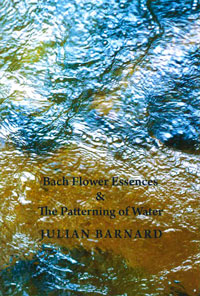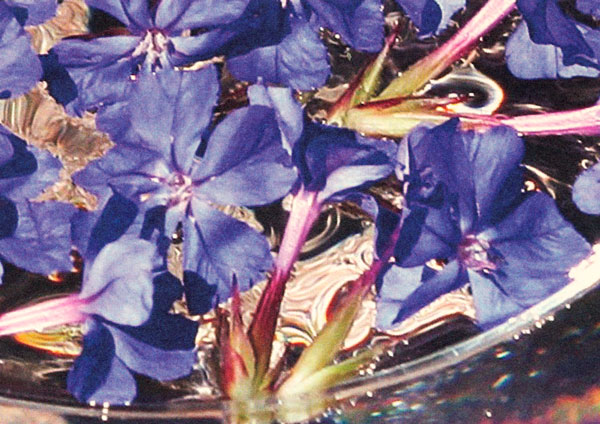
|
|
|
Patterning of Water begins with a brief recapitulation of “form and function,” discussed much more fully in Barnard’s book, Bach Flower Remedies: Form and Function . He is addressing the question of how the structure and growth patterns of plants give clues to their working in the human organism and psyche. This understanding harkens back to the alchemical teachings of Paracelsus known as the “Doctrine of Signatures,” which at its most basic understanding is a recognition that the same living (etheric) formative forces that give rise to the plant, are also operative within human beings. Thus, there are correspondences to be found between what is within us and what we find “outside” in Nature. However, the main subject of this essay is not so much the plants themselves, but how water, as a matrix for the flower essences, is able to carry the healing messages of the flowers to the human psyche. Indeed, this is a question that baffles modern materialists, who take the absence of an active biochemical agent as proof that the flower essences cannot work except as placebos. Flower essences are often considered under the category of “Vibrational Medicine,” working via vibrational resonance. (See Vibrational Medicine , by Richard Gerber, for example.) Just as there are healing effects from light or electromagnetic stimulation, the idea is that vibrational medicines transmit a different kind of energy, often called “subtle energy,” which is not directly measurable by conventional instrumentation. Barnard proposes another paradigm for understanding flower essences, the transmission of information, rather than energy. His hypothesis is grounded in direct observation of the process of making flower essences, both by the sun method and the boiling method. For example, he has observed, and documented with photographs in the book, how as the flower essence water is warmed, it forms bubbles, interior surfaces, and how the surface of the water creates patterns surrounding the plant material. Theodor Schwenk, in his book , The Basis of Potentization Research discusses the importance of surfaces for allowing water to be “sensitive” to influences. Barnard describes this process as “imprinting,” and how this is particularly potent for the “new born” spring water that emerges from the earth.
From the book: Water patterns form around the Cerato blossoms in the mother essence bowl . There is scientific research suggesting that water is a much more active substance than would be indicated by the simple chemical formula H2O. The dynamic bonds within water molecules and between clusters of molecules seem to have the capability of being patterned by other substances and influences. Various picture-forming techniques cited in the book, such as sensitive crystallization and water drop patterning attempt to make visible these imprinted patterns. Then, how is the information pattern contained in the matrix of the mother essence water transmitted to the human psyche, so that it can impact our own awareness and experience? Barnard proposes the hypothesis of the “passive force field.” We are surrounded by active force fields, from the gravitational field of the earth that orients all life, to the proliferation of electromagnetic fields (EMF), whose effects may be more pronounced than we realize. Passive force fields, as Barnard explains, are not measurable fields that transmit energy, but rather patterns that transmit information, or meaning. Examples given in the book include symbols, sacred architecture, art, posture and movement (such as Qi Gong), and writing, particularly pictorial script. Barnard likens our ability to receive the message of a flower essence’s passive force field to the ability to read a book. That implies a skill to be learned, and for the practitioner and flower essence researcher, there is much to learn about the language of the flowers. However, flower essences impact beings whether they have studied them or not, and especially so for small children, animals and plants. What is essential is the openness of hearts and minds to receive the healing messages of the flowers, which have been imprinted into the mother matrix of the water. This book is not a scientific treatise, nor is it a tightly organized reference book, nor a treatise from someone who claims to have all the answers. Rather, one has the impression of listening to a respected colleague share his questions, thoughts and insights culled from a lifetime of experience, as he invites us all to continue with him along the path of discovery on which he embarked so many years ago. |
|

|
Richard Katz
|
| Bach Flower Essences & The Patterning of Water is available from Healingherbs in the UK . | |

To install this Web App in your iPhone/iPad press ![]() and then Add to Home Screen.
and then Add to Home Screen.

